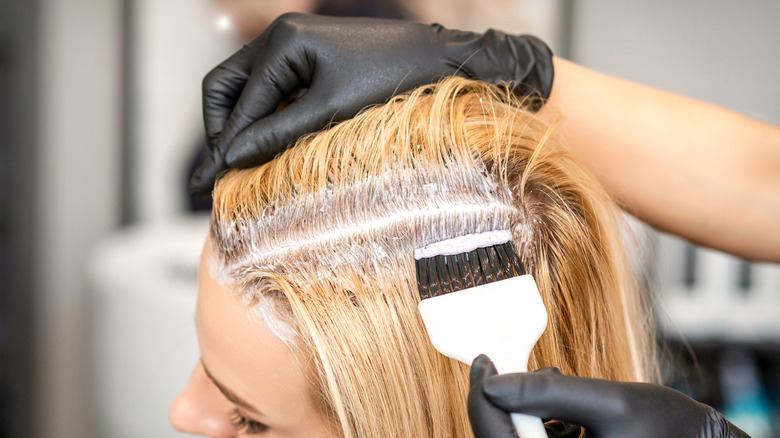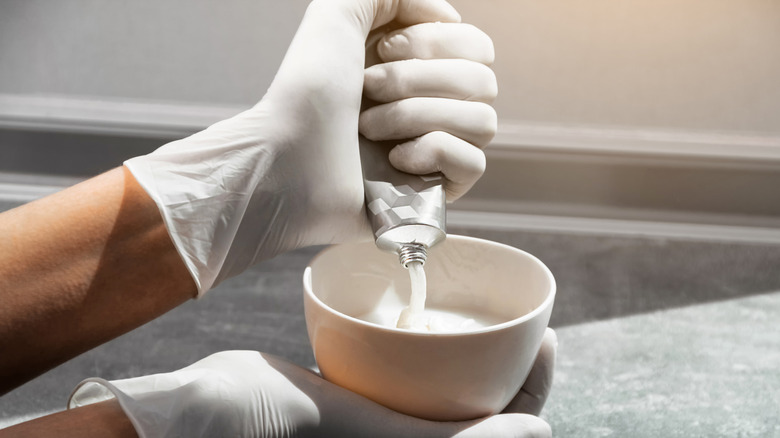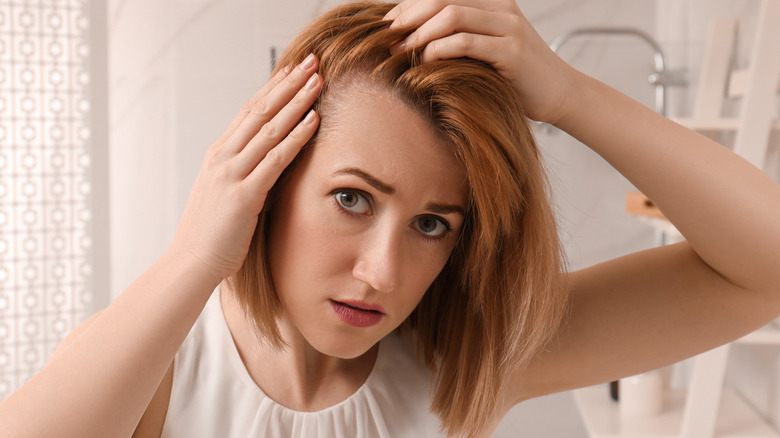Lightening Your Hair Soon? Here's How You Can Prevent Painful Bleach Burn On Your Scalp
Bleaching your full head of hair is a refreshing, bold way to change up your look. To be clear, bleach is very different from hair dye. "Bleach is used for lightening hair (to strip the pigment from your hair shaft) ... It is impossible to make your hair a lighter shade without the help of bleaching or oxidizing agents," hair colorist Lorena M. Valdes told Seventeen.
Whether you're going full platinum or a shade of champagne, these bright hues can give you an energizing bolt of confidence. However, these fun colors can have some not-so-fun side effects. Per Healthline, bleach is made from a mixture of strong chemicals. For a shade that requires extreme lightening, like platinum blonde, it can be difficult to prevent hair damage. Not only that, but if done incorrectly, it can lead to chemical burns on the scalp. Here is what you need to know before you bleach your tresses.
The risks of hair bleaching
There are two kinds of hair bleaching that you can have done at the salon — "on-scalp" and "off-scalp" bleaching. "On-scalp" refers to a bleach application that reaches all the way up to the root of the hair, while "off-scalp" refers to bleach that is not applied to the scalp at all. If you want something like Kim Kardashian's Met Gala platinum, you'll need an "on-scalp" treatment. Considering her look made people wonder if her hair would fall out, "on-scalp" bleaching is the kind of extreme coverage that can lead to safety complications and the risk of a chemical scalp burn.
According to a 2012 report published in Annals of Burn and Fire Disasters, bleach typically includes H2O2, persulphates, and alkalizers. The article notes that if your hair bleach contains levels of H202 (also known as hydrogen peroxide) above 10%, it can cause scalp blistering. Although many of us don't realize it, the scalp is just as delicate and irritation-prone as the skin on your face. "Typically, a bleach burn is a first-degree burn that affects the outer layer of skin, leaving you with a red, painful scalp. However, you can get a more severe burn that extends beyond the top layer of skin and leaves blistering and swelling," board-certified dermatologist Dr. Nazanin Saedi explained to Seventeen.
How you can prevent bleach from burning your scalp
The first simple step to preventing bleach burn is to have it done by a certified hair professional — the intense hair chemicals involved with hair bleach are not typically DIY friendly. Secondly, you'll want to avoid washing your hair for two to three days before your salon. "The oils from your hair help to protect your scalp during the bleaching process," hairstylist Laura Estroff explained to Bustle.
In addition, you'll want to do a "patch test" to ensure you are not allergic to the chemicals. This involves having your stylist put a small dab of the bleach either behind your ear or underside of your forearm. After 48 hours, if there is no adverse reaction, you can assume you are safe to go forward with the treatment. The Burn and Reconstructive Centers of America recommends that you inspect your scalp for any redness or scabbing after you rinse out the bleach. These may be indicators of a chemical burn, which could require medical treatment to prevent the wound from worsening.


